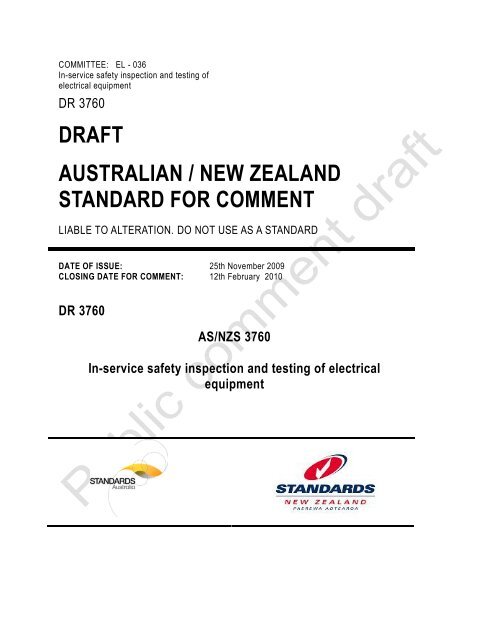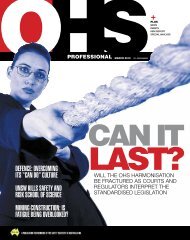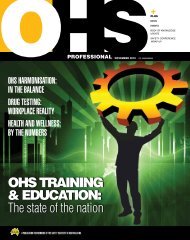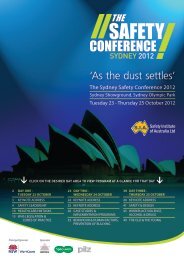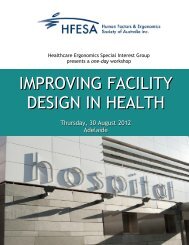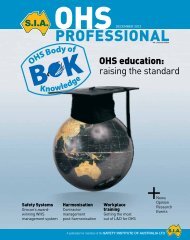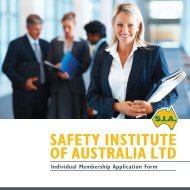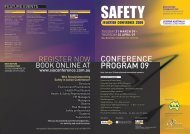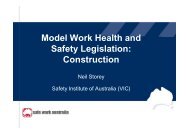In-service safety inspection and testing of electrical equipment
In-service safety inspection and testing of electrical equipment
In-service safety inspection and testing of electrical equipment
You also want an ePaper? Increase the reach of your titles
YUMPU automatically turns print PDFs into web optimized ePapers that Google loves.
PUBLIC COMMENT DRAFTDR 3760Australian/New Zeal<strong>and</strong> St<strong>and</strong>ard<strong>In</strong>-<strong>service</strong> <strong>safety</strong> <strong>inspection</strong><strong>and</strong> <strong>testing</strong> <strong>of</strong> <strong>electrical</strong><strong>equipment</strong>Superseding AS/NZS 3760:20035 <strong>of</strong> 46
PUBLIC COMMENT DRAFTCommittee RepresentationThis draft St<strong>and</strong>ard was prepared under the supervision <strong>of</strong> the EL-036 Committee the St<strong>and</strong>ards Council establishedunder the St<strong>and</strong>ards Act 1988.The committee consisted <strong>of</strong> representatives <strong>of</strong> the following:Nominating OrganisationAustralian Chamber <strong>of</strong> Commerce <strong>and</strong> <strong>In</strong>dustryAustralian <strong>In</strong>dustry Group (AIG)Australasian Lighting <strong>In</strong>dustry AssociationBuilding Service Contractors <strong>of</strong> New Zeal<strong>and</strong> (<strong>In</strong>c.)Consulting <strong>In</strong>terests AustraliaConsulting <strong>In</strong>terests New Zeal<strong>and</strong>Consumer Electronic Suppliers’ AssociationDepartment <strong>of</strong> Labour New Zeal<strong>and</strong>Department Fair Trading, New South Wales Consumer ProtectionAgencyElectro Technical Association New Zeal<strong>and</strong>Energy Safe VictoriaHire <strong>and</strong> Rental Association AustralianHire <strong>In</strong>dustry Association <strong>of</strong> New Zeal<strong>and</strong>Housing <strong>In</strong>dustry Association Australia<strong>In</strong>stitute <strong>of</strong> Electrical <strong>In</strong>spectors AustraliaJoint Accreditation System <strong>of</strong> Australia <strong>and</strong> New Zeal<strong>and</strong> (JAS-ANZ)Ministry <strong>of</strong> Consumer Affairs New Zeal<strong>and</strong>Ministry <strong>of</strong> Economic Development New Zeal<strong>and</strong>National Electrical <strong>and</strong> Communications Association AustraliaNew Zeal<strong>and</strong> Electric Fence Energizers Manufacturers St<strong>and</strong>ardsNew Zeal<strong>and</strong> Council <strong>of</strong> EldersSafety <strong>In</strong>stitute <strong>of</strong> AustraliaSchneider Electric Limited New Zeal<strong>and</strong>WorkCover New South WalesAcknowledgementSt<strong>and</strong>ards New Zeal<strong>and</strong> gratefully acknowledges the contribution <strong>of</strong> time <strong>and</strong> expertise from all those involved indeveloping this St<strong>and</strong>ard.CopyrightThe copyright <strong>of</strong> this document is the property <strong>of</strong> the St<strong>and</strong>ards Council. No part <strong>of</strong> the text may be reproduced byphotocopying or by any other means without the prior written approval <strong>of</strong> the Chief Executive Officer <strong>of</strong> St<strong>and</strong>ards NewZeal<strong>and</strong> unless the circumstances are covered by Part III <strong>of</strong> the Copyright Act 1994.St<strong>and</strong>ards New Zeal<strong>and</strong> will vigorously defend the copyright in this St<strong>and</strong>ard. Every person who breaches St<strong>and</strong>ardsNew Zeal<strong>and</strong>’s copyright may be liable to a fine not exceeding $50,000 or to imprisonment for a term not to exceed 3months. If there has been a flagrant breach <strong>of</strong> copyright, St<strong>and</strong>ards New Zeal<strong>and</strong> may also seek additional damagesfrom the infringing party, in addition to obtaining injunctive relief <strong>and</strong> an account <strong>of</strong> pr<strong>of</strong>its.Published by St<strong>and</strong>ards New Zeal<strong>and</strong>, the trading arm <strong>of</strong> the St<strong>and</strong>ards Council, Private Bag 2439, Wellington 6140.Telephone: (04) 498 5990, Fax: (04) 498 5994, Website: http://www.st<strong>and</strong>ards.co.nz.6 <strong>of</strong> 46
PUBLIC COMMENT DRAFTContentsCommittee representation……………………………………………………………………………………………IFCAcknowledgement…………………………………………………………………………………………………….IFCCopyright……………………………………………………………………………………………………………….IFCReferenced documents……………………………………………………………………………………………....IFCLatest revisions……………………………………………………………………………………………….……….IFCReview <strong>of</strong> St<strong>and</strong>ards …………………………………………………………………………………………………IFCForeword……………………………………………………………………………………………………………….IFCSection 1 – Scope <strong>and</strong> general1.1 Scope……………………………………………………………………………………………………………31.2 General………………………………………………………………………………………………………….41.3 <strong>In</strong>terpretation……………………………………………………………………………………………………41.4 Definitions……………………………………………………………………………………………………….5Section 2 – <strong>In</strong>spection <strong>and</strong> tests2 General………………………………………………………………………………………………………….92.1 Frequency <strong>and</strong> <strong>inspection</strong> <strong>and</strong> tests…………………………………………………………………………92.2 Personnel……………………………………………………………………………………………………….92.3 <strong>In</strong>spection <strong>and</strong> <strong>testing</strong>…………………………………………………………………………………………92.4 Action resulting from <strong>inspection</strong> <strong>and</strong> <strong>testing</strong>……………………………………………………...............132.5 Documentation requirements………………………………………………………………………………..14AppendicesA Test <strong>of</strong> earthing continuity...................................................................................................................... 19B <strong>In</strong>sulation <strong>testing</strong> .................................................................................................................................... 21C <strong>In</strong>uslation resistance <strong>testing</strong> <strong>of</strong> portable isolating transformers............................................................. 24D Test for the operating time <strong>of</strong> residual current devices (RCDs)............................................................. 27E <strong>In</strong>sulation resistance <strong>testing</strong> <strong>of</strong> a power pack ........................................................................................ 29F Polarity for cord extension sets <strong>and</strong> cords sets ..................................................................................... 31G Background............................................................................................................................................ 33H Regulatory application <strong>of</strong> this St<strong>and</strong>ard ................................................................................................. 35J Guidelines on the <strong>electrical</strong> knowledge <strong>of</strong> a competent person ............................................................ 39K Arc welders ............................................................................................................................................ 40TablesTable 1 – Leakage rates………………………………………………………………………………………...........13Table 2 – <strong>In</strong>sulation resistance limits………………………………………………………………………………...13Table 3 – Maximum tripping times…………………………………………………………………………….……..14Table 4 – <strong>In</strong>dicative <strong>testing</strong> <strong>and</strong> <strong>inspection</strong> intervals for <strong>electrical</strong> <strong>equipment</strong>………………………………..…17Table D1 – Tripping time accuracy.................................................................................................................27Table F1 – Conductor colours for flexible cords……………………………………………………….....….…….31FiguresFigure A1 – Measurement <strong>of</strong> earth continuity resistance between accessible earthed parts <strong>and</strong> the earthedpin <strong>of</strong> the mains plug…................................................................................................................20Figure A2 – Measurement <strong>of</strong> the earth continuity resistance between the mains plug earth pin <strong>and</strong> theearthing contacts <strong>of</strong> a power board……………………………………………………………………20Figure B1 – Measurement <strong>of</strong> the insulation resistance between live supply conductors <strong>and</strong> accessible metalparts <strong>of</strong> typical Class I Appliances……………………………………………………………….……22Figure B2 – Measurement <strong>of</strong> the insulation resistance between live supply conductors <strong>and</strong> external metalparts <strong>of</strong> a typical Class II appliance…………………………………………………………………...23Figure B3 – Measurement <strong>of</strong> the insulation resistance <strong>of</strong> a power board……………………………………….23Figure C1 – Measurement <strong>of</strong> the insulation resistance between live supply conductors to a portable isolationtransformer <strong>and</strong> accessible earthed parts <strong>of</strong> unearthed metal parts or enclosing case…………25Figure C2 – Measurement <strong>of</strong> the insulation resistance between live supply conductors <strong>and</strong> the portableisolation transformer output (secondary) winding……………………………………………………25Figure C3 – Measurement <strong>of</strong> the insulation resistance between a portable isolation transformer (secondary)winding <strong>and</strong> accessible earthed parts………………………………………………………………...267 <strong>of</strong> 46
PUBLIC COMMENT DRAFTFigure E1 – Measurement <strong>of</strong> the insulation resistance <strong>of</strong> a power pack………………………………………..29Figure F1 – Detachable IEC cord set…………………………………………………………………………........31Figure F2 – Extension cord set………………………………………………………………………………..…….318 <strong>of</strong> 46
PUBLIC COMMENT DRAFTREFERENCED DOCUMENTSReference is made in this document to the following:JOINT AUSTRALIAN/NEW ZEALAND STANDARDSAS/NZS 3000:2007AS/NZS 3001:2008AS/NZS 3002:2008AS/NZS 3003:2003AS/NZS 3004.1:2008AS/NZS 3004.2:2008AS/NZS 3012:2003AS/NZS 3019:2007AS/NZS 3100:2002AS/NZS 3112:2004AS/NZS 3190:2009AS/NZS 3191:2008AS/NZS 3199:2007AS/NZS 3350.1:2002AS/NZS 3551:2004AS/NZS 4249:1994AS/NZS 4763 (INT):2006AS/NZS 5761:2005AS/NZS 5762:2005AS/NZS ISO 9000:2005AS/NZS ISO 31000:2009AS/NZS 60335.1:2002AS/NZS 61008.1:2004AS/NZS 61009.1:2004AUSTRALIAN STANDARDSAS 1674.2:2003AS 60529:2004OTHER PUBLICATIONSElectrical installations (known as the Australian/New Zeal<strong>and</strong> wiringrules)Electrical installations – Re-locatable premises (including caravans <strong>and</strong>tents) <strong>and</strong> their site installationsElectrical installations – Shows <strong>and</strong> carnivalsElectrical installations – Patient treatment areas <strong>of</strong> hospitals <strong>and</strong> medical<strong>and</strong> dental practices <strong>and</strong> dialysing locationsElectrical installations – Marinas <strong>and</strong> recreational boats – MarinasElectrical installations – Marinas <strong>and</strong> recreational boats – Recreationalboats installationsElectrical installations – Construction <strong>and</strong> demolition sitesElectrical installations – Periodic verificationApproval <strong>and</strong> test specification – General requirements for <strong>electrical</strong><strong>equipment</strong>Approval <strong>and</strong> test specification – Plugs <strong>and</strong> socket-outletsApproval <strong>and</strong> test specification – Residual current devices (currentoperatedearth-leakage devices)Electric flexible cordsApproval <strong>and</strong> test specification – Cord extension setsSafety <strong>of</strong> household <strong>and</strong> similar <strong>electrical</strong> appliances – GeneralrequirementsTechnical management programs for medical devicesElectrical <strong>safety</strong> practices – Film, video <strong>and</strong> television sitesSafety <strong>of</strong> portable inverters<strong>In</strong>-<strong>service</strong> <strong>safety</strong> <strong>inspection</strong> <strong>and</strong> <strong>testing</strong> – Second-h<strong>and</strong> <strong>electrical</strong><strong>equipment</strong> prior to sale<strong>In</strong>-<strong>service</strong> <strong>safety</strong> <strong>inspection</strong> <strong>and</strong> <strong>testing</strong> – Repaired <strong>electrical</strong> <strong>equipment</strong>Quality management systems – Series <strong>of</strong> St<strong>and</strong>ardsRisk managementHousehold <strong>and</strong> similar <strong>electrical</strong> appliances – General requirementsResidual current operated circuit-breakers without integral overcurrentprotection for household <strong>and</strong> similar uses (RCCBs) – General rulesResidual current operated circuit-breakers with integral overcurrentprotection for household <strong>and</strong> similar uses (RCBOs) – General rulesSafety in welding <strong>and</strong> allied processes – ElectricalDegrees <strong>of</strong> protection provided by enclosures (IP Code)WCO0425Risk management at work: Guide – WorkCover NSWWCO0963Risk assessment code <strong>of</strong> practice – WorkCover NSWWCO1336 Competent person for <strong>testing</strong> <strong>and</strong> tagging <strong>electrical</strong> <strong>equipment</strong> –WorkCover NSWUEENEEP008ACommonwealth <strong>of</strong> Australia Unit St<strong>and</strong>ard for training a Competentperson2 <strong>of</strong> 46
PUBLIC COMMENT DRAFTLATEST REVISIONSSt<strong>and</strong>ards are living documents which reflect progress in science, technology <strong>and</strong> systems. To maintaintheir currency, all St<strong>and</strong>ards are periodically reviewed, <strong>and</strong> new editions are published. Betweeneditions, amendments may be issued. St<strong>and</strong>ards may also be withdrawn. It is important that readersassure themselves they are using a current St<strong>and</strong>ard, which should include any amendments which mayhave been published since the St<strong>and</strong>ard was purchased.Detailed information about joint Australian/New Zeal<strong>and</strong> St<strong>and</strong>ards can be found by visiting the St<strong>and</strong>ardsAustralia website at http://www.st<strong>and</strong>ards.com.au or the St<strong>and</strong>ards New Zeal<strong>and</strong> website athttp://www.st<strong>and</strong>ards.co.nz <strong>and</strong> looking up the relevant St<strong>and</strong>ard in the online catalogue.For more frequent listings or notification <strong>of</strong> revisions, amendments <strong>and</strong> withdrawals, St<strong>and</strong>ards Australia<strong>and</strong> St<strong>and</strong>ards New Zeal<strong>and</strong> <strong>of</strong>fer a number <strong>of</strong> update options. For information about these <strong>service</strong>s,users should contact their respective national St<strong>and</strong>ards organisation.REVIEW OF STANDARDSWe also welcome suggestions for improvement in our St<strong>and</strong>ards, <strong>and</strong> especially encourage readers tonotify us immediately <strong>of</strong> any apparent inaccuracies or ambiguities. Please address your comments to theChief Executive <strong>of</strong> either St<strong>and</strong>ards Australia or St<strong>and</strong>ards New Zeal<strong>and</strong>.3 <strong>of</strong> 46
PUBLIC COMMENT DRAFTFOREWORD<strong>In</strong>-<strong>service</strong> <strong>testing</strong> is necessary for the <strong>safety</strong> <strong>of</strong> persons using the <strong>equipment</strong> <strong>and</strong> the proper discharge <strong>of</strong>the obligations <strong>of</strong> employers <strong>and</strong> employees, as listed in legislation covering occupational health <strong>and</strong><strong>safety</strong> matters. This St<strong>and</strong>ard specifies in-<strong>service</strong> <strong>safety</strong> <strong>inspection</strong> <strong>and</strong> <strong>testing</strong> protocols <strong>and</strong> criteria thatsatisfy these obligations, <strong>and</strong> provides a cost-effective approach to <strong>safety</strong> without jeopardizing personnel<strong>safety</strong> or involving excessive <strong>equipment</strong> downtime.The philosophy <strong>of</strong> the document is to provide an <strong>inspection</strong> <strong>and</strong> <strong>testing</strong> regime capable <strong>of</strong> implementationwith only simple instrumentation, <strong>and</strong> performed by a person not necessarily having formal qualificationsor registration, but who has the necessary practical <strong>and</strong> theoretical skills, acquired through training,qualification, experience or a combination <strong>of</strong> these, to correctly undertake the tasks prescribed by thisSt<strong>and</strong>ard.The methodology <strong>of</strong> the <strong>inspection</strong> <strong>and</strong> <strong>testing</strong> process is defined. The frequency <strong>of</strong> repetition <strong>of</strong> thatprocess is determined not by the <strong>equipment</strong> type, but by examination <strong>of</strong> the environment in which the<strong>equipment</strong> is used or working. For indicative purposes a number <strong>of</strong> different environments are providedwith associated <strong>inspection</strong>/<strong>testing</strong> frequencies suggested. These are based on the perception <strong>of</strong> the level<strong>of</strong> hazard <strong>and</strong> the degree <strong>of</strong> abuse to which the <strong>equipment</strong> is typically exposed. However, there willusually be multiple sub-environments within any location <strong>and</strong> the inspecting/<strong>testing</strong> frequency will bearrived at by an assessment <strong>of</strong> the actual environment in which the <strong>equipment</strong> is placed or used.This edition has undergone a complete revision.4 <strong>of</strong> 46
STANDARDS AUSTRALIA/STANDARDS NEW ZEALANDAustralian/New Zeal<strong>and</strong> St<strong>and</strong>ard<strong>In</strong>-<strong>service</strong> <strong>safety</strong> <strong>inspection</strong> <strong>and</strong> <strong>testing</strong><strong>of</strong> <strong>electrical</strong> <strong>equipment</strong>SECTION 1 – SCOPE AND GENERAL1.1 SCOPEThis St<strong>and</strong>ard specifies procedures for the <strong>safety</strong> <strong>inspection</strong> <strong>and</strong> <strong>testing</strong> <strong>of</strong> low voltage single phase <strong>and</strong>polyphase <strong>electrical</strong> <strong>equipment</strong>, connected to the <strong>electrical</strong> supply by a flexible cord <strong>and</strong>/or connectingdevice, which is new <strong>equipment</strong> placed into <strong>service</strong> for the first time, is already in-<strong>service</strong>, has been<strong>service</strong>d or repaired, is returning to <strong>service</strong> from a second-h<strong>and</strong> sale, or is available for hire.This St<strong>and</strong>ard also includes fixed RCDs <strong>and</strong> portable inverters that generate or produce low voltage.NOTE — Additional requirements for portable generators are covered by AS/NZS 3012.Typical examples <strong>of</strong> <strong>equipment</strong> covered by this St<strong>and</strong>ard are:(a)(b)(c)(d)(e)(f)(g)Portable, h<strong>and</strong>-held <strong>and</strong> stationary appliances, designed for connection to the low voltage supplyby a flexible cord <strong>and</strong> plug;Cord sets, cord extension sets <strong>and</strong> outlet devices (also known as <strong>electrical</strong> portable outlet devices,EPODs or power boards);Flexible cords connected to fixed <strong>equipment</strong> in hostile environments;Portable <strong>safety</strong> isolation transformers (includes power adaptor/plug-pack, both <strong>of</strong> the transformer<strong>and</strong> switch-mode type);RCDs – portable type (PRCD), socket outlet type, <strong>and</strong> fixed switchboard type;Battery chargers including commercial <strong>and</strong> industrial;Portable <strong>and</strong> transportable heavy duty tools such as high pressure washers <strong>and</strong> concrete grinders.1.1.1This St<strong>and</strong>ard does not apply to <strong>electrical</strong> <strong>equipment</strong> (such as suspended light fittings), at a height <strong>of</strong>2.5 m or greater above the ground, floor or platform, where there is not a reasonable chance <strong>of</strong> a persontouching the <strong>equipment</strong> <strong>and</strong>, at the same time, coming into contact with earth or any conducting mediumwhich may be in <strong>electrical</strong> contact with earth or through which a circuit may be completed to earth.1.1.2This St<strong>and</strong>ard does not apply to <strong>equipment</strong> which would need to be dismantled to perform the <strong>inspection</strong><strong>and</strong> tests specified in this St<strong>and</strong>ard.1.1.3NOTE — If, for some reason outside the scope <strong>of</strong> this St<strong>and</strong>ard, <strong>equipment</strong> has to be dismantledto verify <strong>safety</strong>, this action is only to be performed by a technically qualified person.Functional checks are not included in this St<strong>and</strong>ard.1.1.4This St<strong>and</strong>ard applies only to <strong>equipment</strong> in-<strong>service</strong> at a place <strong>of</strong> work or public place, or <strong>of</strong>fered for hire.1.1.5This St<strong>and</strong>ard does not apply to fixed or stationary <strong>equipment</strong> connected to wiring that forms part <strong>of</strong> the5 <strong>of</strong> 46
<strong>electrical</strong> installation <strong>and</strong> falls within the scope <strong>of</strong> AS/NZS 3000.1.1.6This St<strong>and</strong>ard does not apply to <strong>equipment</strong> whose nature is that <strong>of</strong> a medical device as defined inAS/NZS 3551.1.1.7This St<strong>and</strong>ard does not apply to demonstration stock in retail or wholesale outlets.1.2 GENERALEquipment needs to be subjected to regular <strong>inspection</strong> <strong>and</strong> <strong>testing</strong> to detect obvious damage, wear orother conditions which might render it unsafe. Equipment shall not be dismantled to perform <strong>inspection</strong><strong>and</strong> <strong>testing</strong>, nor tested to destruction.NOTE — Unless otherwise specified, all a.c. voltage <strong>and</strong> current values referenced are expressed in rootmean square (r.m.s) values.1.2.1 New <strong>equipment</strong>1.2.1.1<strong>In</strong> Australia, when the <strong>equipment</strong> is new, the supplier is deemed responsible for its initial <strong>electrical</strong> <strong>safety</strong>.New <strong>equipment</strong> need not be tested but shall be examined for obvious damage. Where deemed compliantthe owner or Responsible person shall ensure it is tagged in accordance with 2.4.2.1.1.2.1.2NOTE — This clause is drawn to the attention <strong>of</strong> owners <strong>of</strong> computer <strong>and</strong> <strong>of</strong>fice <strong>equipment</strong>, who mayarrange for the tagging action to be undertaken by their in-house Competent person.<strong>In</strong> New Zeal<strong>and</strong>, the <strong>equipment</strong> shall be inspected, tested <strong>and</strong> tagged on entry to <strong>service</strong>.1.2.2 <strong>In</strong>-<strong>service</strong> <strong>equipment</strong>Equipment already in-<strong>service</strong> shall be inspected <strong>and</strong> tested in accordance with Section 2.1.2.3 Fixed or stationary <strong>equipment</strong>Fixed or stationary <strong>equipment</strong> connected by fixed cable or flexible cord:(a)(b)Which is not flexed in normal use or exposed to damage nor is in a hostile environment, does notnormally constitute a hazard sufficient to warrant routine in-<strong>service</strong> <strong>electrical</strong> <strong>safety</strong> <strong>testing</strong>.Accordingly, the <strong>testing</strong> <strong>of</strong> such <strong>equipment</strong> is not required by this St<strong>and</strong>ard;Where the flexible cable or cord is flexed on <strong>equipment</strong> which is moved for restocking,maintenance, cleaning, for example, shall require in-<strong>service</strong> <strong>testing</strong>.1.2.4 Hire <strong>equipment</strong>1.2.4.1 Responsibility for hire <strong>equipment</strong> at the commencement <strong>of</strong> hire(a) New <strong>equipment</strong> from the supplier shall enter <strong>service</strong> in the hire industry in accordance with 1.2.1;(b)(c)The hirer has the responsibility to ensure that hired <strong>equipment</strong> complies with the requirements <strong>of</strong>this St<strong>and</strong>ard at the commencement <strong>of</strong> hire;Hirers may combine the function <strong>of</strong> the tag specified in 2.4.2 <strong>and</strong> their in-house 'Ready for hire'tag,by colour-coding it to comply with 2.4.2.1.2.4.2 Responsibility for hire <strong>equipment</strong> during hireResponsibility for <strong>testing</strong>, <strong>inspection</strong> <strong>and</strong> tagging passes to the hiree. The appropriate time interval toretest shall be derived from Table 4, by assessing the environment in which the <strong>equipment</strong> is utilized.6 <strong>of</strong> 46
1.3 INTERPRETATION1.3.1The terms ‘normative’ <strong>and</strong> ‘informative’ have been used in this St<strong>and</strong>ard to define the application <strong>of</strong> theappendix to which they apply. A ‘normative’ appendix is an integral part <strong>of</strong> a St<strong>and</strong>ard <strong>and</strong> subject to thesame level <strong>of</strong> compliance as if it were in the body <strong>of</strong> the St<strong>and</strong>ard, whereas an ‘informative’ appendix isprovided for information <strong>and</strong> guidance, <strong>and</strong> may indicate good practice. Non-compliance with aninformative appendix will not be seen as non-compliance with the St<strong>and</strong>ard.1.3.2 Shall <strong>In</strong>dicates a statement is m<strong>and</strong>atory to achieve compliance with this St<strong>and</strong>ard.1.3.3 Should <strong>In</strong>dicates a statement is preferred as indicating good practice, but is not m<strong>and</strong>atory.1.3.4 May <strong>In</strong>dicates the existence <strong>of</strong> an option.1.3.5 Clause references are provided without prefix as the clause number only, for example 2.3.21.4 DEFINITIONSFor the purpose <strong>of</strong> this St<strong>and</strong>ard, the following definitions shall apply:1.4.1 Accessible earthed parts(a)Accessible earthed parts are a conductive part <strong>of</strong> <strong>electrical</strong> <strong>equipment</strong>, required to be connected toa protective earth, which:(i)(ii)(iii)Are separated from live parts by basic insulationCan be touched with the jointed test finger as specified in AS 60529, <strong>and</strong>Are not a live part but can become live if basic insulation fails.(b)The term accessible earthed parts does not apply to the following:(i)(ii)Parts separated from live parts by double insulation or reinforced insulation, or by othermetal parts themselves earthed or having double insulation or reinforced insulationMetal nameplates, screwheads, covers or plates, <strong>and</strong> their means <strong>of</strong> fixing, which cannotbecome live in the event <strong>of</strong> failure <strong>of</strong> insulation <strong>of</strong> live parts, or be exposed to arcing contactwith live partsNOTE — ‘Failure <strong>of</strong> insulation’ in this context is taken to include accidental bridging <strong>of</strong> an insulatinggap by metal, or partially conducting material, such as carbon dust or moisture, as well as <strong>electrical</strong>breakdown.(iii)Parts within an enclosure, the cover <strong>of</strong> which requires the use <strong>of</strong> a tool for its removalNOTE — A key is not considered to be a tool except where special circumstances prevail, for example,the use <strong>of</strong> the key is restricted to technical <strong>service</strong> personnel having an appropriate level <strong>of</strong>electrotechnical training.(iv)Parts within <strong>equipment</strong>, the configuration <strong>and</strong> mass <strong>of</strong> which are such that the parts are notaccessible during normal use <strong>and</strong> movement <strong>of</strong> the <strong>equipment</strong>.NOTE — Non-metallic material that is conductive to a degree, <strong>and</strong> may contribute to a hazardouscondition arising shall be deemed to be an accessible earthed part, subject to the above provisions.1.4.2 Accessible unearthed partsAccessible unearthed parts are all external parts that are not connected to the protective earthingconductor <strong>and</strong> are separated from live parts by double insulation or reinforced insulation, <strong>and</strong> includesparts used to support the <strong>equipment</strong> in operation.1.4.3 Class I <strong>equipment</strong> (basic insulated, protectively earthed <strong>equipment</strong>)Equipment in which protection against electric shock does not rely on basic insulation only, but whichincludes an additional level <strong>of</strong> protection, in that conductive accessible parts are connected to the7 <strong>of</strong> 46
protective earthing conductor in the fixed wiring <strong>of</strong> the installation in such a way that those accessibleparts cannot become live in the event <strong>of</strong> a failure <strong>of</strong> the basic insulation.NOTE —(1) Class I <strong>equipment</strong> may have parts with double insulation or parts operating at extra-low voltage;(2) This provision includes a protective earthing conductor as part <strong>of</strong> the flexible cord or cable for<strong>equipment</strong> intended for use with a flexible cord or cable;(3) Other Classes are described in AS/NZS 60335.1.1.4.4 Class II <strong>equipment</strong> (double insulated <strong>equipment</strong>)Equipment in which protection against electric shock does not rely on basic insulation only, but in whichan extra layer <strong>of</strong> insulation (called 'supplementary insulation') is provided to give double insulation, therebeing no provision for protective earthing or reliance upon installation conditions. This <strong>equipment</strong> isgenerally manufactured with a non-conductive (insulated) enclosure, <strong>and</strong> is marked either with the words‘DOUBLE INSULATED’ or with the symbolNOTE —to allow easy identification.(1) Class II <strong>equipment</strong> may also be manufactured with metal enclosures which are double insulated fromlive parts.(2) Class II <strong>equipment</strong> may be provided with an earth connection for purposes other than <strong>safety</strong>, thisearth connection is referred to as a functional earth. Functionally earthed parts are double insulatedfrom live parts.1.4.5 Competent personA Competent person is one who the Responsible person ensures has the necessary practical <strong>and</strong>theoretical skills, acquired through training, qualification, experience or a combination <strong>of</strong> these, tocorrectly undertake the required tasks.NOTE —(1) A Competent person is not required to be a registered or licensed <strong>electrical</strong> practitioner.(2) Competency levels may need to be updated following technological advances in both the <strong>testing</strong>instrumentation available <strong>and</strong> the <strong>equipment</strong> being examined.(3) It is expected that the Competent person will:(i)(ii)(iii)(iv)(v)Be able to use test <strong>equipment</strong> safely <strong>and</strong> effectivelyHave an underst<strong>and</strong>ing <strong>of</strong> the dangers <strong>of</strong> electricity, leading to an appreciation <strong>of</strong> the need for<strong>inspection</strong> <strong>and</strong> <strong>testing</strong>Have an underst<strong>and</strong>ing <strong>of</strong> the construction <strong>of</strong> Class I <strong>and</strong> Class II <strong>equipment</strong>, <strong>and</strong> <strong>of</strong> theterms: basic insulation, supplementary insulation, reinforced insulation <strong>and</strong> double insulation,protective earth <strong>and</strong> earth continuity, insulation resistance <strong>and</strong> earth leakage currentHave an underst<strong>and</strong>ing <strong>of</strong> the application <strong>and</strong> requirements <strong>of</strong> this St<strong>and</strong>ardHave an underst<strong>and</strong>ing <strong>of</strong> the relevant legislative requirements appropriate for the jurisdictionthey are operating in(4) Guidelines to the knowledge <strong>of</strong> <strong>electrical</strong> principles with which a Competent person is likely to befamiliar are listed in Appendix J which also provides references to other useful documents such asthe Commonwealth <strong>of</strong> Australia Unit St<strong>and</strong>ard UEENEEP008A.1.4.6 Cord set(a)(b)Detachable. An assembly <strong>of</strong> a country-specific plug intended for connection to a mains outletsocket, a sheathed flexible cord <strong>and</strong> an appliance connector.NOTE — An example <strong>of</strong> a detachable cord set is shown in Appendix F, figure F1.Non-detachable. An assembly <strong>of</strong> a country-specific plug intended for connection to a mains outletsocket, <strong>and</strong> a sheathed flexible cord which enters the <strong>equipment</strong> directly, without an applianceconnector.1.4.7 Cord extension setAn assembly <strong>of</strong> a country-specific plug intended for connection to a mains outlet socket, a sheathed8 <strong>of</strong> 46
flexible cord <strong>and</strong> a cord extension socket,NOTE — An example <strong>of</strong> a cord extension set is shown in Appendix F, figure F2.1.4.8 Electric portable outlet device (Power boards <strong>and</strong> EPODs)A device, other than a cord set, or cord extension set having a single means <strong>of</strong> connection to a lowvoltage supply, <strong>and</strong> one or more outlet facilities. It may incorporate a reeling or coiling arrangement.1.4.9 Fixed <strong>equipment</strong>Equipment which is fastened to a support, secured in position or otherwise, due to its size <strong>and</strong> mass,located in a specific location.1.4.10 HireNOTE — Adhesives are not recognized as a means <strong>of</strong> fastening fixed <strong>equipment</strong> to a support unlessspecifically allowed in another St<strong>and</strong>ard.A hire situation is created when the hirer provides <strong>electrical</strong> <strong>equipment</strong>, to a person or entity external tothe hirer’s organization, which passes out <strong>of</strong> the control <strong>of</strong> the hirer. A situation where <strong>equipment</strong> issupplied <strong>and</strong> operated by the hirer is not considered to constitute a hire.1.4.11 HireeThe person or business, which receives the <strong>equipment</strong> from the hirer.1.4.12 HirerThe person or business which <strong>of</strong>fers the <strong>equipment</strong> for hire.1.4.13 Hostile environmentOne in which the <strong>equipment</strong> or appliance is normally subjected to events or operating conditions likely toresult in damage to the <strong>equipment</strong> or a reduction in its expected life span. This includes, but is not limitedto physical abuse, exposure to moisture, heat, vibration, corrosive chemicals, <strong>and</strong> dust.1.4.14 <strong>In</strong>sulationOne or a combination <strong>of</strong> the following:(a)Basic insulationThe insulation applied to live parts to provide basic protection against electric shock;NOTE —(1) Basic insulation does not include insulation used exclusively for functional purposes.(2) Basic insulation was previously known as single insulation.(b)(c)(d)Supplementary insulationAn independent insulation, applied in addition to the basic insulation, in order to ensure protectionagainst electric shock in the event <strong>of</strong> a failure <strong>of</strong> the basic insulation;Double insulation<strong>In</strong>sulation comprising both basic insulation <strong>and</strong> supplementary insulation;Reinforced insulationA single insulation system applied to live parts, which provides a degree <strong>of</strong> protection againstelectric shock equivalent to double insulation, under conditions specified in this St<strong>and</strong>ard.NOTE — The term ‘insulation system’ does not imply that the insulation must be one homogenous piece. Itmay comprise several layers which cannot be tested singly as supplementary or basic insulation.1.4.15 Isolating transformerA transformer, the input winding <strong>of</strong> which is <strong>electrical</strong>ly separated from the output winding by an insulationat least equivalent to double insulation or reinforced insulation.9 <strong>of</strong> 46
1.4.16 Live partsLive parts include live supply conductors <strong>and</strong> all parts which are <strong>electrical</strong>ly connected to the line supplyconductors. While the neutral wire shall also be considered a live part, the protective earth is not a livepart. An accessible earthed part is not a live part but can become live if basic insulation fails.1.4.17 Portable <strong>equipment</strong>Equipment which is moved while in operation, or an appliance which can be easily moved from one placeto another while connected to the supply.1.4.18 Power supplyCommonly known as plug pack, power supply, <strong>and</strong> extra low voltage power supply unit or a.c. adaptor.1.4.19 Residual current device (RCD)A mechanical switching device designed to make, carry <strong>and</strong> break currents under normal <strong>service</strong>conditions, <strong>and</strong> to cause the opening <strong>of</strong> the contacts when the residual current attains a given valueunder specified conditions.RCDs are classified in AS/NZS 3190 according to their rated residual current as follows:(a) Type I : 10 mA;(b) Type II : > 10 mA 30 mA;NOTE — More information may be found in AS/NZS 61008.1 Residual current operated circuit-breakerswithout integral overcurrent protection for household <strong>and</strong> similar uses (RCCBs) – General rules, <strong>and</strong>AS/NZS 61009.1 Residual current operated circuit-breakers with integral overcurrent protection forhousehold <strong>and</strong> similar uses (RCBOs) – General rules.1.4.20 Responsible personThe Responsible person shall be considered as the owner <strong>of</strong> the premises, or the <strong>electrical</strong> <strong>equipment</strong>, oran employer, who has a legal responsibility under the occupational health <strong>and</strong> <strong>safety</strong> legislation or therelevant regulatory jurisdiction, for the <strong>safety</strong> <strong>of</strong> <strong>electrical</strong> <strong>equipment</strong> within the scope <strong>of</strong> this St<strong>and</strong>ard.Guidelines to assist a Responsible person to assess the knowledge <strong>of</strong> a Competent person are set out inAppendix J.1.4.23 Stationary <strong>equipment</strong>An appliance having a mass exceeding 18 kg.1.4.24 Supply flexible cordA flexible cable or cord, for supply purposes, which has one end connected to a plug with pins designedto engage with a socket outlet, <strong>and</strong> the other end connected to terminals within the <strong>equipment</strong>.1.4.25 VoltageDifferences <strong>of</strong> potential, normally existing between conductors <strong>and</strong> between conductors <strong>and</strong> earth asfollows:(a)(b)(c)Extra-low voltage (ELV) – not exceeding 50 V a.c. or 120 V ripple free d.c.;Low voltage (LV) – exceeding extra-low voltage, but not exceeding 1000 V a.c. or 1500 V d.c.;High voltage (HV) – exceeding low voltage.10 <strong>of</strong> 46
2. GENERALSECTION 2 – INSPECTION AND TESTSExperience has shown that greater than 90 % <strong>of</strong> defects are detectable by visual <strong>inspection</strong>. Therefore,<strong>equipment</strong> shall be visually inspected, physically checked <strong>and</strong> tested in accordance with this section.The frequency <strong>of</strong> repetition <strong>of</strong> that process is determined not by the <strong>equipment</strong> type, but by examination<strong>of</strong> the environment in which the <strong>equipment</strong> is used or working in.For indicative purposes a number <strong>of</strong> environments are shown in column (a) <strong>of</strong> Table 4. These are basedon the perception <strong>of</strong> the level <strong>of</strong> hazard <strong>and</strong> the degree <strong>of</strong> abuse to which the <strong>equipment</strong> is typicallyexposed.However, there will usually be multiple subenvironments within any location <strong>and</strong> the inspecting/<strong>testing</strong>frequency will be arrived at by an assessment by the Responsible person, <strong>of</strong> the actual environment inwhich the <strong>equipment</strong> is placed or used.2.1 FREQUENCY OF INSPECTION AND TESTSElectrical <strong>equipment</strong> shall be inspected <strong>and</strong> tested:(a)(b)(c)2.1.1At intervals indicated in Table 4, or as varied by a Responsible person based on a risk assessment;NOTE — Regulatory authorities, other St<strong>and</strong>ards, workplace <strong>safety</strong> requirements or manufacturers’instructions may specify shorter or longer intervals appropriate to particular industries or specific types <strong>of</strong><strong>equipment</strong>.Before return to <strong>service</strong> after a repair or servicing, which could have affected the <strong>electrical</strong> <strong>safety</strong> <strong>of</strong>the <strong>equipment</strong>. AS/NZS 5762 may apply.Before placement in <strong>service</strong>, if sourced from a second-h<strong>and</strong> sale, to ensure the <strong>equipment</strong> is safe.AS/NZS 5761 shall apply.To allow the flexibility to devise a customized solution for particular circumstances, organizations withsufficient expertise <strong>and</strong> resource may substitute other periods than those indicated in Table 4, afterconducting a documented risk assessment, undertaken in accordance with the process specified inAS/NZS ISO 31000, <strong>and</strong> taking into consideration any relevant legislative requirements or guidelines.2.1.1.1This risk assessment option shall not apply to <strong>equipment</strong> <strong>of</strong>fered for hire.NOTE — This exclusion has been made as the hirer has no control over the end use <strong>of</strong> the <strong>equipment</strong> <strong>and</strong>therefore a risk assessment could not be conducted by the hirer.2.2 PERSONNELThe <strong>inspection</strong> <strong>and</strong> <strong>testing</strong> tasks specified in this St<strong>and</strong>ard shall be carried out by a Competent person asdefined in 1.4.5. The frequency <strong>of</strong> retest shall be assessed by the Responsible person as defined in1.4.20.2.3 INSPECTION AND TESTING2.3.1 GeneralWhere applicable, in-<strong>service</strong> <strong>testing</strong> <strong>and</strong> <strong>inspection</strong> shall include:(a)(b)(c)(d)(e)An external <strong>inspection</strong> <strong>of</strong> the <strong>equipment</strong> <strong>and</strong> the connecting facilities (for example, supply flexiblecord);Protective earth continuity tests for Class I <strong>equipment</strong>, power boards <strong>and</strong> cord sets;<strong>In</strong>sulation <strong>testing</strong>, which may be achieved by measuring insulation resistance, or leakage current;Confirmation <strong>of</strong> the correct polarity <strong>of</strong> live connections in cord extension sets with rewireable plugs<strong>and</strong> cord extension sockets;Confirmation <strong>of</strong> the correct polarity <strong>of</strong> live connections in cord sets with rewireable plugs <strong>and</strong>connectors.11 <strong>of</strong> 46
NOTE —(1) Clear backed plugs <strong>and</strong> cord extension sockets facilitate the easy <strong>inspection</strong> <strong>of</strong> the effectiveness <strong>of</strong>the sheath grip <strong>and</strong> polarity checking.(2) There are items incorporating an <strong>electrical</strong>ly held relay, which require voltage to maintain continuity.Such items may require application <strong>of</strong> rating voltage to allow <strong>testing</strong>.2.3.2 <strong>In</strong>spectionThe following <strong>equipment</strong> checks shall be made by visual <strong>and</strong> physical <strong>inspection</strong> <strong>of</strong> all <strong>equipment</strong>:(a)(b)(c)(d)(e)(f)(g)(h)(i)Check for obvious damage or defects in the accessories, connectors, plugs or extension outletsockets; <strong>and</strong> for discoloration that may indicate exposure to heat, chemicals or moisture;Check that flexible cords are effectively anchored to <strong>equipment</strong>, plugs, connectors <strong>and</strong> cordextension sockets;NOTE — This <strong>inspection</strong>, including flexing <strong>and</strong> straining at points <strong>of</strong> entry <strong>and</strong> clamping points by theapplication <strong>of</strong> reasonable combination <strong>of</strong> push/pull <strong>and</strong> rotary movements, may detect broken str<strong>and</strong>s orloose connections. It may be conveniently performed in conjunction with the continuity test to 2.3.31.Check for damage to flexible cords to ensure that:(i)(ii)(iii)NOTE —The inner cores <strong>of</strong> flexible cords are not exposed or twisted; <strong>and</strong>The external sheaths are not cut, abraded, twisted, or damaged to such an extent thatthe insulation <strong>of</strong> the inner cores is visible; <strong>and</strong>Unprotected conductors or the use <strong>of</strong> b<strong>and</strong>ing insulation tape are not in evidence.(1) Carefully running the flexible cord through the h<strong>and</strong> will <strong>of</strong>ten detect internal damage such as twistedconductors or broken core filling.(2) Connecting the plugs/cord extension sockets <strong>of</strong> cord extension sets together helps to confirm that theterminals have not spread.For portable outlet devices (power boards), check that the warning indicating the maximum load tobe connected to the device is intact <strong>and</strong> legible;Check that any operating controls are in good working order i.e. that they are secure, aligned <strong>and</strong>appropriately identified;Check that covers, guards, <strong>and</strong> the like are secured in the manner intended by the manufacturer orsupplier;Check that ventilation inlets <strong>and</strong> exhausts are unobstructed;The pins <strong>of</strong> insulated pin plugs should be inspected for damage to the insulation <strong>of</strong> the pins, <strong>and</strong>, iffitted, the shroud on cord extension sockets;Check that the current rating <strong>of</strong> the plug is consistent with the current rating <strong>of</strong> the <strong>equipment</strong>.2.3.3 TestingThe purpose <strong>of</strong> <strong>testing</strong> is to detect the unobservable faults not found by the visual <strong>inspection</strong> process, <strong>and</strong>forms an integral part <strong>of</strong> the <strong>inspection</strong>/<strong>testing</strong> process.2.3.3.1 Earthing continuityTo confirm that the resistance <strong>of</strong> the protective earth circuit is sufficiently low to ensure correct operation<strong>of</strong> the circuit protecting the <strong>equipment</strong>, the continuity <strong>of</strong> the protective earthing conductor from the plugearth pin to accessible earthed parts <strong>of</strong> all Class I <strong>equipment</strong> shall be checked;The continuity <strong>of</strong> the protective earth conductor from the earth pin <strong>of</strong> the plug to the earth contact <strong>of</strong> theoutlet(s) <strong>of</strong> cord sets, cord extension sets, outlet devices <strong>and</strong> portable residual current devices, (PRCDs)shall be checked.Such <strong>equipment</strong> shall be tested in accordance with Appendix A <strong>and</strong> shall have a measured resistance <strong>of</strong>the protective earth circuit, or the protective earthing conductor which does not exceed 1.NOTE — This test is best undertaken during <strong>inspection</strong> performed under 2.3.2(b).12 <strong>of</strong> 46
2.3.3.2 Testing <strong>of</strong> insulation<strong>In</strong>sulation resistance tests shall be performed with the switch in the 'on'position. If the <strong>equipment</strong> must beenergized to close or operate a switching device, then a leakage current test shall be performed.Equipment shall be tested:(a)(b)With a leakage current test performed at rated voltage with values not exceeding those specified inTable 1; orWARNING – When performing leakage current tests with the <strong>equipment</strong> energized, the protective earthconductor may be live <strong>and</strong> present a shock hazard.Alternatively, measure insulation resistance in accordance with Appendix B at 500 V d.c. oralternatively, to avoid the <strong>equipment</strong> apparently failing the test because the metal oxide varistors(MOVs), or electro-magnetic interference (EMI) suppression has triggered, for <strong>equipment</strong>containing voltage limiting devices such as MOVs, or EMI suppression, at 250 V d.c. Theinsulation resistance between parts <strong>of</strong> the <strong>equipment</strong> shall be as specified in Table 2.TABLE 1 - Leakage current limitsEquipmentClass IClass IIPortable RCDs with functionalearthCord extension sets, portableoutlets <strong>and</strong> portable RCDsLeakage testMeasure the current flowing in theprotective earth conductorMeasure the current flowing betweenaccessible unearthed metal <strong>and</strong> earthMeasure the current flowing in thefunctional earth conductorMeasure the current flowing in theprotective earth conductorMaximum leakagemA512.51EquipmentClass IClass IITABLE 2 - <strong>In</strong>sulation resistance limits<strong>In</strong>sulation testMeasure between live parts <strong>and</strong>accessible earthed partsWith live <strong>and</strong> neutral conductors<strong>electrical</strong>ly connected, measurebetween live parts <strong>and</strong> any accessiblemetal partsMinimum insulationresistance M1.01.0Portable RCDs with functionalearthMeasure between live parts <strong>and</strong> thefunctional earthing conductor0.1Cord extension sets, cord sets,portable outlets <strong>and</strong> portableRCDsMeasure between live parts <strong>and</strong> theprotective earthing conductor 1.0Mineral insulated metal sheathheating elementsMeasure between live parts <strong>and</strong>accessible earthed parts0.0113 <strong>of</strong> 46
2.3.3.2.1Where <strong>equipment</strong> contains, by design, resistors installed between live conductors <strong>and</strong> earth, values <strong>of</strong>insulation resistance not less than the effective value <strong>of</strong> the resistors are acceptable provided themanufacturer can prove that the resistors are part <strong>of</strong> the design.2.3.3.2.2The insulation resistance <strong>of</strong> RCDs with functional earth (FE) connections shall be not less than 0.1 M asshown in Table 2. Alternatively, portable RCDs which require the supply to be closed, <strong>and</strong> units with a FEconnection may be tested for leakage current with a maximum allowed value <strong>of</strong> 2.5 mA as shown in Table1. (A functional earth in an RCD is a connection with earth to ensure the correct normal operation <strong>of</strong> theRCD.)2.3.3.3 Testing <strong>of</strong> plug packs, power supply, portable isolation transformers <strong>and</strong> power packsTesting shall be performed between the following components as appropriate:(a)(b)(c)(d)2.3.3.3.1Live supply conductors <strong>and</strong> accessible earthed parts <strong>of</strong> the Class I transformer or enclosing case;Live supply conductors <strong>and</strong> accessible metal parts <strong>of</strong> Class II transformers or enclosing case;Live supply conductors <strong>and</strong> the connections from the transformer output (secondary) winding;Connections from the transformer output (secondary) winding <strong>and</strong> earthed accessible earthedparts. This test is not applicable for <strong>equipment</strong> with ELV output which is connected to earth directlyor by a resistive component.The insulation resistance between appropriate parts specified above shall be not less than 1 M.2.3.3.4 Test for operation <strong>of</strong> RCDsRCDs shall be tested in accordance with Appendix D. The maximum tripping time for RCDs measured inaccordance with Appendix D or using an external timer circuit as described in Note 2, shall not exceedthe values shown in Table 3.NOTE —(1) The test for operating time using a.c. for a.c. <strong>and</strong> d.c. pulse sensitive RCDs is acceptable as d.c.calibration is linked to a.c. calibration <strong>and</strong> verified by type test.(2) Portable RCDs which are permanently wired to terminals in <strong>equipment</strong> may be tested by push buttononly, observing the operating time, which should be ’without undue delay’. <strong>In</strong> case <strong>of</strong> doubt, use anexternal timer circuit, capable <strong>of</strong> detecting the test current start <strong>and</strong> finish, to measure disconnecttime. (The test button current is assumed to be 200 % x rated residual current).(3) The test methods for RCDs in 2.3.3.4 <strong>and</strong> Appendix D <strong>of</strong> this St<strong>and</strong>ard may be used to verify RCDoperation where required in other St<strong>and</strong>ards for initial verification or periodic verification at intervalsspecified in those other St<strong>and</strong>ards, for example AS/NZS 3000, AS/NZS 3019, AS/NZS 3012, AS/NZS3001, AS/NZS 3002.TABLE 3 - Maximum tripping timesRCD typeTest currenta.c. mAMaximum tripping timemsType I 10 40Type II 30 3002.3.3.5 Polarity <strong>of</strong> rewireable plugs <strong>and</strong> cord extension socketsThe correct polarity <strong>of</strong> the individual wires in rewireable plugs <strong>and</strong> cord extension sockets is shown in (a)<strong>and</strong> (b) below, <strong>and</strong> additional details <strong>of</strong> older <strong>and</strong> overseas schemes are provided in Appendix F. Theindicative frequency <strong>of</strong> test is provided in column (h) <strong>of</strong> Table 4.14 <strong>of</strong> 46
(a)(b)PlugsThe order (polarity) <strong>of</strong> the pins <strong>of</strong> a three pin flat pin plug, to their connections, shall be Earth (radialpin – green/yellow wire), Neutral (blue wire) <strong>and</strong> then Active (brown wire), in a clockwise direction,when viewed from the front <strong>of</strong> the plug looking at the pins.Cord extension socketsThe order (polarity) <strong>of</strong> the socket apertures <strong>of</strong> a three pin flat pin socket, to their connections, shallbe Earth (radial pin – green/yellow wire), Active (brown wire) <strong>and</strong> then Neutral (blue wire), in aclockwise direction, when viewed from the front <strong>of</strong> the socket looking at the apertures.2.3.3.6 Testing <strong>of</strong> a portable generatorDetails <strong>of</strong> <strong>testing</strong> for portable generators are provided in AS/NZS 3012.2.3.3.7 Testing <strong>of</strong> arc welders with exposed terminalsA brief description <strong>of</strong> the main types <strong>of</strong> welding power supplies is provided in Appendix K.(a)(b)<strong>In</strong>spect both mains <strong>and</strong> welding leads for damage or excessive charring;For transformer types, treat as a Class I device, test the insulation resistance <strong>of</strong> exposed metalparts, measure the insulation resistance between the supply plug <strong>and</strong> output terminals if possible<strong>and</strong> confirm that the mains voltage does not appear at the output terminals.2.3.3.8 Testing <strong>of</strong> portable invertersTesting <strong>of</strong> portable inverters is specified in Annex F <strong>of</strong> AS/NZS 4763.2.3.3.9 Testing <strong>of</strong> Class I items which are totally encapsulatedSome <strong>equipment</strong> is manufactured by taking a Class I item <strong>and</strong> encapsulating it entirely so that althoughan item has a cord set with a protective earth conductor which is applicable to the Class I device, there isno access to the <strong>equipment</strong> to confirm its efficacy by test. When it is suspected that the <strong>equipment</strong> is <strong>of</strong>this nature, because the earth continuity cannot be verified, inspect the cord set carefully as usual, <strong>and</strong>test the insulation by either the earth leakage or megger approaches.2.3.3.10 Testing <strong>of</strong> three phase <strong>equipment</strong>All relevant tests shall be applied except that the test for insulation shall be an insulation resistancemeasurement to 2.3.3.2 (b) performed on each phase in turn.NOTE — A leakage test to 2.3.3.2 (a) is not acceptable as it may indicate a low value due to the vector sum<strong>of</strong> each phase leakage current to earth, when in fact, each phase is above the limit.2.4 Action resulting from <strong>inspection</strong> <strong>and</strong> <strong>testing</strong>2.4.1 Non-compliant <strong>equipment</strong>Where in-<strong>service</strong> <strong>inspection</strong> or <strong>testing</strong> identifies <strong>equipment</strong> which fails to comply with the criteria given inthis St<strong>and</strong>ard, the <strong>equipment</strong> shall be appropriately labelled to indicate that the <strong>equipment</strong> requiresremedial action <strong>and</strong> warn against further use. Such <strong>equipment</strong> shall be withdrawn from <strong>service</strong>. Thechoice <strong>of</strong> remedial action, disposal or other corrective action shall be determined by the owner or theperson responsible for the <strong>safety</strong> <strong>of</strong> the site.2.4.2 Compliant <strong>equipment</strong>Where in-<strong>service</strong> <strong>inspection</strong> <strong>and</strong> <strong>testing</strong> identifies <strong>equipment</strong> which complies with the criteria given in thisSt<strong>and</strong>ard, the <strong>equipment</strong> shall be fitted with a tag or other indicator. Special <strong>equipment</strong> shall not berequired to identify the <strong>equipment</strong>.NOTE — This does not preclude tags from also bearing a code to facilitate electronic data collection.2.4.2.1The tag, shall be durable, legible, non-reusable, non-metallic <strong>and</strong> may be colour coded to identify theperiod in which the test was performed, <strong>and</strong> shall include all <strong>of</strong> the following information as a minimum:(a)The name <strong>of</strong> the person or company who performed the test;15 <strong>of</strong> 46
(b)2.4.2.2The test or <strong>inspection</strong> date, <strong>and</strong> may also include a retest date.NOTE —(1) Some regulatory authorities or other St<strong>and</strong>ards, such as AS/NZS 3012 <strong>and</strong> the AS/NZS ISO 9000series, may require other <strong>inspection</strong> <strong>and</strong> test records to be kept.(2) AS/NZS 4249 <strong>and</strong> AS/NZS 3012 provide guidance on one method <strong>of</strong> colour coding. Alternativemethods are acceptable.(3) Australian regulators, as listed in Appendix H, may require colour coding which complies with theirparticular State legislation.Where a tag provides coded information required under 2.4.2.1 (a) <strong>and</strong> (b), such that a purpose-builtreader is required to easily determine that information, then records shall be available on site for audit, onthe next working day.NOTE — Such <strong>equipment</strong> should be marked or labelled to facilitate its ready identification from the use <strong>of</strong>such records.2.5 DOCUMENTATION REQUIREMENTS2.5.1Where records <strong>of</strong> test <strong>and</strong> <strong>inspection</strong> are kept, the following should be recorded:(a)(b)(c)(d)2.5.2A register <strong>of</strong> all <strong>equipment</strong>;A record <strong>of</strong> formal <strong>inspection</strong> <strong>and</strong> tests;A 'repair'register;A record <strong>of</strong> all faulty <strong>equipment</strong> showing details <strong>of</strong> <strong>service</strong>s or corrective actions.NOTE —(1) Electrical <strong>and</strong>/or occupational health <strong>and</strong> <strong>safety</strong> regulators may require documentation to be kept insome or all cases.(2) Where organizations perform voluntary additional <strong>inspection</strong>s <strong>and</strong> tests, records <strong>of</strong> such should bekept.Where records are kept, they should be retained for 7 years, or such period as required by the specificregulations.2.5.3Where a risk assessment has been performed in accordance with 2.1.1, all documentation shall beretained for 7 years or such period as may be required by the relevant regulator.16 <strong>of</strong> 46
PUBLIC COMMENT DRAFTTABLE 4<strong>In</strong>dicative <strong>testing</strong> <strong>and</strong> <strong>inspection</strong> intervals for <strong>electrical</strong> <strong>equipment</strong>(CAUTION: This page must be read in conjunction with the St<strong>and</strong>ard as a whole, <strong>and</strong> particularly Clause 2.1)<strong>In</strong>terval between <strong>inspection</strong> <strong>and</strong> testsType <strong>of</strong> environment <strong>and</strong>/or<strong>equipment</strong>(a)1 Factories, workshops,places <strong>of</strong> work or repair,manufacturing, assembly,maintenance or fabricationClass <strong>of</strong> <strong>equipment</strong>Class I(protectivelyearthed)(b)Class II(doubleinsulated)(c)6 months 12 monthsResidual current devices (RCDs)Push-button test – by userPortable(d)Daily, or beforeevery use,whichever is thelongerFixed(e)Operating time <strong>and</strong> pushbuttontestPortable(f)Fixed(g)Cord sets <strong>and</strong>power boards6 months 12 months 12 months 6 months(h)2 Environment where the<strong>equipment</strong> or supply flexiblecord is subject to flexing innormal use OR is open toabuse OR is in a hostileenvironment3 Environment where the<strong>equipment</strong> or supply cord isNOT subject to flexing innormal use <strong>and</strong> is NOTopen to abuse <strong>and</strong> is NOTin a hostile environment4 Residential type areas <strong>of</strong>:hotels, residential institutions,motels, boarding houses, halls,hostels accommodationhouses, <strong>and</strong> the like12 months 12 months 3 months 6 months 12 months 12 months 12 months5 years 5 years 3 months 6 months 2 years 2 years 5 years2 years 2 years 6 months 6 months 2 years 2 years 2 years17 <strong>of</strong> 46
PUBLIC COMMENT DRAFT<strong>In</strong>terval between <strong>inspection</strong> <strong>and</strong> testsType <strong>of</strong> environment <strong>and</strong>/or<strong>equipment</strong>(a)5 Equipment used forcommercial cleaningClass <strong>of</strong> <strong>equipment</strong>Class I(protectivelyearthed)(b)Class II(doubleinsulated)(c)Residual current devices (RCDs)Push-button test – by userPortable(d)Fixed(e)Operating time <strong>and</strong> pushbuttontestPortable(f)Fixed(g)Cord sets <strong>and</strong>power boards6 months 12 months 3 months N/A 12 months N/A 12 months(h)6 Hire <strong>equipment</strong>:<strong>In</strong>spectionPrior to hire<strong>In</strong>cluding push-button test by hirerprior to hireN/A N/A Prior to hireTest <strong>and</strong> tag 3 months N/A 3 months 12 months 3 months7 Repaired, <strong>service</strong>d <strong>and</strong>second-h<strong>and</strong> <strong>equipment</strong>After repair or <strong>service</strong> which could affect <strong>electrical</strong> <strong>safety</strong>, or on reintroduction to <strong>service</strong>, refer to AS/NZS 5762NOTE —(1) The actual sub-environment in which the <strong>equipment</strong> is located determines the row for the environment to be used in Table 4, for example, A computer in a non-hostileenvironment in an <strong>of</strong>fice within a factory would attract a test/<strong>inspection</strong> action in accordance with Row 3.(2) Regulatory authorities, other St<strong>and</strong>ards, workplace <strong>safety</strong> requirements or manufacturers’ instructions may specify intervals appropriate to particular industries or specifictypes <strong>of</strong> <strong>equipment</strong>.(3) RCDs in transportable <strong>equipment</strong> shall be regarded as portable RCDs.(4) The following St<strong>and</strong>ards refer only to the <strong>inspection</strong> <strong>and</strong> <strong>testing</strong> method <strong>of</strong> Clause 2.4 <strong>of</strong> this St<strong>and</strong>ard, but not to the intervals <strong>of</strong> <strong>testing</strong> in Table 4 above. Refer to theappropriate St<strong>and</strong>ards for specific test intervals:AS 1674.2AS/NZS 3001AS/NZS 3002AS/NZS 3003AS/NZS 3004.1 <strong>and</strong> .2AS/NZS 3012AS/NZS 4249Safety in welding <strong>and</strong> allied processes – ElectricalElectrical installations – Re-locatable premises (including caravans <strong>and</strong> tents) <strong>and</strong> their site installationsElectrical installations – Shows <strong>and</strong> carnivalsElectrical installations – Patient treatment areas <strong>of</strong> hospitals <strong>and</strong> medical <strong>and</strong> dental practices <strong>and</strong> dialyse locationsElectrical installations – Marinas <strong>and</strong> pleasure craft at low voltageElectrical installations – Construction <strong>and</strong> demolition sitesElectrical <strong>safety</strong> practices – Film, video <strong>and</strong> television sites18 <strong>of</strong> 46
APPENDIX ATEST OF EARTHING CONTINUITY(Normative)A1 GENERALThe test <strong>of</strong> earthing continuity resistance shall be conducted to 2.3.3.1 during in-<strong>service</strong> <strong>testing</strong> <strong>of</strong>all Class I <strong>equipment</strong>. The test shall include flexing <strong>and</strong> straining at points <strong>of</strong> entry <strong>and</strong> clampingpoints by the application <strong>of</strong> reasonable combination <strong>of</strong> push/pull <strong>and</strong> rotary movements. This maydetect broken str<strong>and</strong>s or loose connections.A2 INSTRUMENTATIONFor 'in-<strong>service</strong>'<strong>testing</strong>, either <strong>of</strong> the following shall be used:(a)(b)An ohmmeter <strong>of</strong> accuracy Class 5 or better; orNOTE — Class 5 denotes an accuracy <strong>of</strong> 5 % full scale deflection.An <strong>equipment</strong> tester (portable appliance tester or PAT) with one or more <strong>of</strong> the following testcapabilities:(i)(ii)(iii)12 V maximum, test current in the range 100 to 200 mA;NOTE — This mode is commonly known as an 'earth continuity'test.12 V maximum, test current <strong>of</strong> 10 A The test duration is limited to the maximum timerequired for measurement;NOTE — This mode is commonly known as a 'routine test'.12 V maximum, at 1.5 times the rated current <strong>of</strong> the appliance or 25 A, whichever isthe greater. The test duration is limited to the maximum time required formeasurement. The use <strong>of</strong> this option is not recommended <strong>and</strong> caution should beexercised when considering its application to an item containing electroniccomponents.NOTE — This mode is commonly known as a 'type test'.A3 TEST CONDITIONSA3.1 Earthing continuity resistance shall be measured between any accessible earthed parts,including rotating metal parts, <strong>and</strong> the earth pin <strong>of</strong> the plug. The resistance shall not exceed 1 .A3.2 For cord sets, cord extension sets, portable outlet devices, <strong>and</strong> portable RCDs, theresistance between the earthing connections <strong>of</strong> the plug <strong>and</strong> outlet(s) shall be measured. Theresistance shall not exceed 1 .NOTE —(1) Figure A1 shows one method <strong>of</strong> <strong>testing</strong> resistance.(2) For the definition <strong>of</strong> accessible earthed parts, see 1.4.1.(3) Values measured (with the flexible cord included), are usually found to comply with a value <strong>of</strong>less than 0.5.(4) Some <strong>testing</strong> personnel remove the active <strong>and</strong> neutral pins <strong>of</strong> the test plug depicted in figureA2, to ensure the earth pin is sufficiently well gripped by the power board earth contacts.Page 19
Figure A1 – Measurement <strong>of</strong> the earth continuity resistance between accessible earthedparts <strong>and</strong> the earth pin <strong>of</strong> the mains plugFigure A2 – Measurement <strong>of</strong> the earth continuity resistance between the mains plug earthpin <strong>and</strong> the earthing contacts <strong>of</strong> a power boardPage 20
APPENDIX BINSULATION TESTING(Normative)B1 GENERAL<strong>In</strong>sulation resistance between live parts <strong>and</strong> accessible earthed parts shall be measured inaccordance with 2.3.3.2 by measuring the leakage current or by measuring the resistance value.Compliance values are provided in Table 1 <strong>and</strong> Table 2.B2INSTRUMENTATION AND METHODB2.1 Leakage current<strong>In</strong> Class I <strong>equipment</strong>, measurement <strong>of</strong> the current flowing in the protective earth conductor shall becarried out while the <strong>equipment</strong> is operating by using one <strong>of</strong> the following methods:(a)(b)(c)A direct reading meter inserted in series with the protective earth wire circuit <strong>of</strong> the test<strong>equipment</strong>; usually by means <strong>of</strong> a custom made jig;A clamp meter in conjunction with a special cord set where the protective earth conductorcan be safely separated for measurement;A portable appliance tester (PAT) incorporating a leakage current measurement facility.The meter shall be capable <strong>of</strong> recording 5 mA ± 5 %.WARNING – When performing leakage current tests with the <strong>equipment</strong> energized, the protective earthconductor may be live <strong>and</strong> present a shock hazard. Safety is enhanced if the item under test is poweredvia a RCD.NOTE — This leakage current test cannot be made using an isolating transformer because thesecondary windings are insulated from earth <strong>and</strong> the earth pin <strong>of</strong> the socket <strong>and</strong> hence there is noreturn path for any leakage current.B2.2 <strong>In</strong>sulation resistanceWhether an insulation resistance meter or a PAT is used, it shall have the following characteristics:(a)(b)(c)A measuring circuit isolated from earth;Provide a nominal measuring voltage <strong>of</strong> 500 V d.c. (250 V d.c. may be used for <strong>equipment</strong>containing MOVs/EMI filtering);NOTE — For guidance on the requirements <strong>of</strong> insulation measuring <strong>equipment</strong>, refer to AS/NZS3000 (that is, maintain terminal voltage within + 20% <strong>and</strong> – 10% when measuring a resistance <strong>of</strong> 1M).An accuracy <strong>of</strong> Class 5 or better.NOTE — Class 5 denotes an accuracy <strong>of</strong> 5 %, full scale deflection.B3 TEST CONDITIONSNOTE — A live part is a conductor or conductive part intended to be energized in normal use,including the neutral conductor. The protective earth conductor is not a live part.B3.1 Class I <strong>equipment</strong> – Live parts to accessible earthed metal partsLeakage current tests have to be performed with the <strong>equipment</strong> energized. The leakage current forappliances shall not exceed 5 mA, except that for a portable RCD (PRCD) it shall not exceed 2.5mA.Page 21
<strong>In</strong>sulation resistance tests shall be performed with the switch in the ‘on’ position, the <strong>equipment</strong> deenergized,<strong>and</strong> the live supply conductors joined together. The resistance shall be not less than 1M, or for RCDs with an FE connection, 0.1 M.If the <strong>equipment</strong> must be energized to close or operate a switching device, then a leakage currenttest shall be performed.NOTE —(1) Figure B1 shows the <strong>testing</strong> <strong>of</strong> insulation resistance <strong>of</strong> accessible earthed parts.(2) Accessible earthed parts are defined in 1.4.1 <strong>and</strong> are required to be earthed.B3.2 Class II <strong>equipment</strong> – Live parts to accessible unearthed parts<strong>In</strong>sulation resistance is measured between the live supply conductors connected together<strong>electrical</strong>ly, <strong>and</strong> external unearthed metal parts, with the mains switch/selector on the <strong>equipment</strong> inthe ‘ON’ position. The resistance measured shall be not less than 1 M.NOTE — Figure B2 shows <strong>testing</strong> <strong>of</strong> insulation resistance <strong>of</strong> external metal parts.B3.3 Cord sets <strong>and</strong> electric portable outlet devices (EPOD)For cord sets, cord extension sets <strong>and</strong> portable outlet devices, the insulation resistance shall bemeasured between live supply conductors connected together <strong>electrical</strong>ly, <strong>and</strong> the earthingconductor, with any mains switch/selector present for the <strong>equipment</strong> in the ‘ON’ position. Theresistance shall be not less than 1 M. When internal components may affect test values obtained,see 2.3.3.2 (b)NOTE — Figure B3 shows the <strong>testing</strong> <strong>of</strong> a power board.Figure B1 – Measurement <strong>of</strong> the insulation resistance between live supplyconductors <strong>and</strong> accessible metal parts <strong>of</strong> typical Class I appliancesPage 22
Figure B2 – Measurement <strong>of</strong> the insulation resistance between live supplyconductors <strong>and</strong> external metal parts <strong>of</strong> a typical Class II applianceFigure B3 – Measurement <strong>of</strong> the insulation resistance <strong>of</strong> a power boardSecretarial Note: <strong>In</strong> the Legend, item 2 “pin” should be “contact” or similarPage 23
APPENDIX CINSULATION RESISTANCE TESTING OF PORTABLE ISOLATING TRANSFORMERS(Normative)C1 GENERAL<strong>In</strong>sulation resistance shall be measured on portable <strong>safety</strong> isolating transformers to 2.3.3.3.C2 INSTRUMENTATIONEither an insulation resistance meter or a PAT is required with the following characteristics:(a)(b)(a)A measuring circuit isolated from earth;Nominal measuring voltage 500 V d.c;Accuracy Class 5 or better.NOTE —(1) Class 5 denotes an accuracy <strong>of</strong> 5 %, full scale deflection.(2) For guidance on the requirements <strong>of</strong> insulation measuring <strong>equipment</strong> refer to AS/NZS 3000.That is, maintain terminal voltage within + 20% <strong>and</strong> – 10% when measuring a resistance <strong>of</strong> 1M.C3 TEST CONDITIONS<strong>In</strong>sulation resistance shall be not less than 1 M <strong>and</strong> shall be measured between:(a)Live supply conductors <strong>and</strong> accessible earthed parts <strong>of</strong> a Class I transformer or enclosingcase;NOTE — A method is shown in Figure C1.(b)(c)(d)Live supply conductors <strong>and</strong> accessible unearthed metal parts <strong>of</strong> Class II transformers orenclosing case;NOTE — A method is shown in Figure C1.Live supply conductors <strong>and</strong> the connections from the transformer output (secondary) winding;NOTE — A method is shown in Figure C2.The connections from the transformer output (secondary) winding <strong>and</strong> accessible earthedparts.NOTE — A method is shown in Figure C3.Page 24
Figure C1 – Measurement <strong>of</strong> the insulation resistance between live supply conductors to aportable isolation transformer <strong>and</strong> accessible earthed parts or unearthed metal parts orenclosing caseFigure C2 – Measurement <strong>of</strong> the insulation resistance between live supply conductors <strong>and</strong>the portable isolation transformer output (secondary) windingPage 25
Figure C3 – Measurement <strong>of</strong> the insulation resistance between a portable isolationtransformer (secondary) winding <strong>and</strong> accessible earthed partsPage 26
APPENDIX DTEST FOR THE OPERATING TIME OF RESIDUAL CURRENT DEVICES (RCDs)(Normative)D1 GENERALD1.1 The operating time <strong>of</strong> RCDs shall be checked to 2.3.3.4 with maximum values acceptableshown in Table 3.D1.2 The following tests are not required by this St<strong>and</strong>ard:(a)(b)(c)Calibration sensitivity at slowly rising current;Non trip threshold (50 % rated sensitivity);d.c. pulse tests for type A. The test for operating time using a.c. for type A RCDs (a.c. <strong>and</strong>d.c. pulse half-wave sensitive) is acceptable as d.c. calibration is linked to a.c. calibration <strong>and</strong>verified by type test. The test for operating time, ensures that both type AC (sine wave a.c.)<strong>and</strong> type A have retained their type test calibration.D2 INSTRUMENTATIONThe RCD tester shall be capable <strong>of</strong> applying rated tripping current ±5% <strong>and</strong> measure time with anaccuracy dependent on the nominal tripping time as follows:Table D1 – Tripping time accuracyTripping TimeAccuracy40 ms ± 2 ms300 ms ± 8 msD3 TEST CONDITIONSD3.1The single-phase RCD. A current, equal to the rated tripping current, shall be ‘suddenly’ appliedbetween active <strong>and</strong> protective earth <strong>and</strong> the operating time measured.NOTE —(1) Tests are applied by the instrument test button (suddenly applied). <strong>In</strong> case <strong>of</strong> doubt, a number<strong>of</strong> test operations, up to five, may be required.(2) Some RCDs may have a different result (approximately 10 ms) depending on the point onwave <strong>of</strong> the test current. <strong>In</strong> case <strong>of</strong> doubt, the operating time at both 0 o <strong>and</strong> 180 o should betested.(3) Load leakage <strong>and</strong> stored energy can affect the result <strong>and</strong> increase the meter trip timeindication. <strong>In</strong> case <strong>of</strong> doubt, all load on the circuit should be disconnected.(4) A 240 V test meter, used on 230 V may give a low test current <strong>and</strong> correspondingly longertimes. Ensure the correct rating <strong>and</strong> tolerance <strong>of</strong> the test instrument.(5) The test from active to earth involves the complete earth fault loop <strong>and</strong> the resistance <strong>of</strong> theearth wire, or current flowing in the earth wire may affect results. <strong>In</strong> case <strong>of</strong> doubt, a benchtest may be required.(6) Portable RCDs which are permanently wired to terminals in <strong>equipment</strong> may be tested by pushPage 27
D3.2button only, <strong>and</strong> observing the operating time, which should be without undue delay. <strong>In</strong> case<strong>of</strong> doubt, use an external timer circuit, to detect the test current start <strong>and</strong> finish, <strong>and</strong> actuallymeasure the disconnect time which should be not more than 150 ms for a 30 mA unit <strong>and</strong> 40ms for a 10 mA unit. (The test button current is assumed to be 200 % x rated residualcurrent.)The three-phase RCD. Tests on three or four pole RCDs used on a three-phase supply shall beconducted with a three-phase supply connected.The tests shall be undertaken individually on each phase in turn, with all load connectionsdisconnected, (including the neutral) as any st<strong>and</strong>ing leakage current on the load side may add orsubtract vectorially from the test current.D3.2.1The test may be performed on a single-phase supply, on one phase only, with all load switchedOFF, if one <strong>of</strong> the following conditions is satisfied:(a)(b)The RCD is verified as having no circuit connections, internal or external to an active orneutral conductor orThe active <strong>and</strong> neutral circuit connections to the RCD are verified to ensure that a currentflowing through the toroid is balanced or cancelled by a return current.NOTE —(1) Test results on three-phase RCDs may be influenced by a residual st<strong>and</strong>ing leakage. Thest<strong>and</strong>ing leakage may add to the residual test current, or subtract from the residual testcurrent, depending on the phase relationship <strong>of</strong> the leakage current to the test current.(2) The st<strong>and</strong>ing leakage may be due to leakage in the load insulation to earth.(3) The st<strong>and</strong>ing leakage may be from incorrect connections allowing a current to bypass thetoroid in one direction. This can result from the RCD supply circuit current itself through thetoroid not being balanced (or cancelled) by a return neutral current through the toroid. Forexample, the RCD active supply is downstream <strong>of</strong> the toroid, but the neutral return is upstream<strong>of</strong> the toroid, or vice versa.Page 28
APPENDIX EINSULATION RESISTANCE TESTING OF A POWER PACK(Normative)E1 GENERAL<strong>In</strong>sulation resistance on power packs shall be measured to 2.3.3.3.E2 INSTRUMENTATIONEither an insulation resistance meter, or a PAT, is required with the following characteristics:(a)(b)(c)A measuring circuit isolated from earth;Nominal measuring voltage 500 V d.c;Accuracy <strong>of</strong> Class 5 or better.NOTE —(1) Class 5 denotes an accuracy <strong>of</strong> 5 %, full scale deflection.(2) For guidance on the requirements <strong>of</strong> insulation measuring <strong>equipment</strong>, refer to AS/NZS 3000,that is, maintain terminal voltage within + 20 % <strong>and</strong> – 10 % when measuring a resistance <strong>of</strong> 1M.E3 TEST CONDITIONS<strong>In</strong>sulation resistance shall be measured between:(a)(b)(c)Live supply conductors <strong>electrical</strong>ly connected together, <strong>and</strong> accessible earthed parts <strong>of</strong> aClass I enclosing case; orLive supply conductors <strong>and</strong> external metal parts <strong>of</strong> a Class II enclosing case; orLive supply conductors <strong>and</strong> the connections from the output.NOTE — A method is shown in Figure E1.E3.1 The insulation resistance measured shall be not less than 1 M.Figure E1 – Measurement <strong>of</strong> the insulation resistance <strong>of</strong> a power packPage 29
APPENDIX FPOLARITY FOR CORD EXTENSION SETS AND CORDS SETS(Normative)F1Cord sets <strong>and</strong> cord extension sets with rewireable plugs <strong>and</strong>/or connectors <strong>and</strong>/or cord extensionsockets shall be checked for correct polarity <strong>of</strong> the wiring.F2The correct wiring for a cord set is shown in Figure F1.F3NOTE — A three-conductor cord with a suitable power plug for the locality in which theappliance is used on one end <strong>and</strong> an IEC C13 line socket on the other is commonly calledan 'IEC cord'.The correct wiring for a cord extension set is shown in Figure F2.F4The recommended conductor colours for the flexible cord are given in Table F1 in the “<strong>In</strong>ternational”column. The other two columns are included for completeness, as older cord sets, cord extensionsets, imported cord sets, <strong>and</strong> imported cord extension sets constructed to differing schemes are stillin use. Until confirmed, caution should be exercised, as the active conductor’s insulation may notbe brown.WARNING When imported, plugs on cord sets based on the USA scheme are frequently removed <strong>and</strong>replaced. Such cord sets should be treated with caution until the correct polarity is confirmed.Table F1 – Conductor colours for flexible cordsFunction <strong>In</strong>ternational Superseded USAActive /Line Brown Red BlackNeutral Light Blue Black WhiteEarth Green <strong>and</strong> Yellow Green GreenF5(a)(b)(c)(d)(e)(f)Modern flexible cords conform to the following colour schemes:Single phase, Class II <strong>equipment</strong>: two-core cord with (usually) blue, brown core insulations;Single phase, Class I <strong>equipment</strong>: three-core cord with green-<strong>and</strong>-yellow, blue, brown coreinsulations;Three phase, delta connected or star connected without neutral, Class II appliances: threecorecord with brown, black, grey core insulations;Three phase, delta connected or star connected without neutral, Class I <strong>equipment</strong>: fourcorecable with green-<strong>and</strong>-yellow, brown, black, grey cord insulations;Three phase, star connected with neutral, Class II <strong>equipment</strong>: four-core cord with blue,brown, black, grey core insulations;Three phase, star connected with neutral, Class I <strong>equipment</strong>: five-core cord green-<strong>and</strong>yellow,blue, brown, black, grey core insulations.Page 30
<strong>In</strong> flexible cords, cores with green-<strong>and</strong>-yellow coloured insulation are reserved for ’earth’ <strong>and</strong> coreswith blue insulation are reserved for neutral.The colour schemes (a) to (f) are in conformance with the latest European <strong>and</strong> internationalSt<strong>and</strong>ards for flexible cords.AENSOCKETCord Sheath SecuredNAEPLUGFigure F1 – Detachable IEC cord setANESOCKETCord Sheath SecuredNAEPLUGFigure F2 – Cord extension setPage 31
APPENDIX GBACKGROUND( I n f o r m a t i v e )G1 GeneralThis appendix provides some background to the <strong>inspection</strong> <strong>and</strong> <strong>electrical</strong> <strong>testing</strong> requirementsspecified in this St<strong>and</strong>ard <strong>and</strong> relevant regulatory codes.For the <strong>safety</strong> <strong>of</strong> people using <strong>electrical</strong> <strong>equipment</strong> the following requirements should be met:(a)(b)(c)(d)(e)Equipment is to be designed <strong>and</strong> manufactured to appropriate <strong>safety</strong> st<strong>and</strong>ards;Equipment, without being dismantled, is to be subjected to routine <strong>inspection</strong> <strong>and</strong> <strong>testing</strong> todetect obvious damage, wear or other conditions which might render it unsafe;Equipment identified as faulty is to be withdrawn from <strong>service</strong> <strong>and</strong> referred for repair ordisposal by expert personnel;Appropriate <strong>equipment</strong> is to be used for each particular application;<strong>In</strong> specific cases, for example, for use in confined spaces, <strong>equipment</strong> is also to be used inaccordance with an appropriate set <strong>of</strong> rules linking the type <strong>of</strong> work with the class <strong>of</strong><strong>equipment</strong> <strong>and</strong> environmental <strong>safety</strong> facilities;This St<strong>and</strong>ard refers only to the matters in items (b) <strong>and</strong> (c).The following information provides some insight <strong>and</strong> background to the <strong>inspection</strong> <strong>and</strong> <strong>electrical</strong><strong>testing</strong> requirements specified in this St<strong>and</strong>ard <strong>and</strong> relevant regulatory codes.G2 Principles <strong>of</strong> construction <strong>of</strong> <strong>electrical</strong> <strong>equipment</strong>Accessible earthed parts <strong>of</strong> <strong>equipment</strong> operating from supply voltage have to be prevented frombecoming live in the event <strong>of</strong> insulation failure or the bypassing <strong>of</strong> insulation during the normal use<strong>of</strong> the <strong>equipment</strong> (for example through the ingress <strong>of</strong> conducting liquids or other conductingmaterials).This protection may be provided by either one or both <strong>of</strong> the following:(a)Provision <strong>of</strong> basic insulation between the accessible earthed parts <strong>and</strong> the live parts, <strong>and</strong>earthing the accessible earthed parts. Equipment for which some or all <strong>of</strong> the accessibleearthed parts require protective earthing, are basic insulated items, which are also referred toas Class I <strong>equipment</strong>.NOTE — Some electric drills have an external metal chuck, which may be double insulated from liveparts. The nameplate marking may indicate this.(b)Provision <strong>of</strong> double or reinforced insulation between the accessible earthed parts <strong>and</strong> the liveparts. Equipment in which none <strong>of</strong> the accessible earthed parts require protective earthing,due to the provision <strong>of</strong> double or reinforced insulation, are double insulated items, alsoreferred to as Class II <strong>equipment</strong>. This <strong>equipment</strong> is generally manufactured with a nonconductive(insulated) enclosure, <strong>and</strong> is marked either with the words ‘DOUBLEINSULATED’ or with the symbolto allow easy identification.NOTE —(1) This type <strong>of</strong> <strong>equipment</strong> cannot be tested for earth continuity or insulation resistance to earth.The insulation resistance can be measured between live parts <strong>and</strong> a flexible electrode (suchPage 32
as aluminum foil) wrapped over the insulation.(2) Some hybrid constructions exist whereby a Class I item is totally encapsulated. By denyingaccess to earthed parts, a protective earth continuity test cannot be performed. <strong>In</strong> these casesonly an insulation test can be performed.G3 Protective earthingThe resistance to earth from protectively earthed parts in Class I <strong>equipment</strong> has to be low enoughto permit adequate fault current to flow to earth, thereby ensuring that the overcurrent protectiondevice in the final sub-circuit (that is, fixed wiring) opens quickly in the event <strong>of</strong> insulation failure.The protective earthing conductor also ensures that any leakage current from the live parts withinClass I <strong>equipment</strong> flows to earth via a low resistance path.G4 <strong>In</strong>sulation resistance<strong>In</strong>sulation resistance <strong>testing</strong> is intended to confirm the integrity <strong>of</strong> the insulation between live mainsparts <strong>and</strong> accessible metal parts.Accordingly, <strong>equipment</strong> has its insulation resistance measured prior to commissioning, <strong>and</strong> atregular intervals during its <strong>service</strong> life to ensure that no degradation has occurred sincemanufacture, during transport, or over its <strong>service</strong> life.G5 Test <strong>equipment</strong>The <strong>equipment</strong> required to carry out the tests detailed in this St<strong>and</strong>ard should be subject to routineverification at regular intervals to ensure it is working correctly <strong>and</strong> its accuracy is maintained.G6 DocumentationRecords <strong>of</strong> maintenance, including (but not limited to) tests, should be kept throughout the workinglife <strong>of</strong> the <strong>equipment</strong>. Such records are a useful management tool for reviewing the frequency <strong>of</strong><strong>inspection</strong> <strong>and</strong> test actions, <strong>and</strong> ensuring these actions have been carried out. It is recommendedthat such records be retained for not less than 7 years.Page 33
APPENDIX HREGULATORY APPLICATION OF THIS STANDARD(<strong>In</strong>formative)H1 GENERALRelevant regulatory authorities in the Australian States <strong>and</strong> Territories <strong>and</strong> in New Zeal<strong>and</strong> mayrequire compliance with this St<strong>and</strong>ard under their various regulatory instruments.The purpose <strong>of</strong> this appendix is to provide contact details <strong>of</strong> the relevant authorities which enforceregulations relating to the in-<strong>service</strong> <strong>inspection</strong> <strong>and</strong> <strong>testing</strong> <strong>of</strong> <strong>electrical</strong> <strong>equipment</strong> in each <strong>of</strong> theAustralian States <strong>and</strong> Territories <strong>and</strong> in New Zeal<strong>and</strong>.This information is accurate at the time <strong>of</strong> publication <strong>of</strong> this St<strong>and</strong>ard. Users are advised to consultthe relevant nominated regulatory authority for information current at the time <strong>of</strong> use.H2 REGULATORY AUTHORITIESNew South WalesWorkCover NSW92-100 Donnison Street, Gosford.Postal Address: Locked Bag 2906, Lisarow NSW 2252WorkCover assistance <strong>service</strong>, Phone: 13 10 50Website: www.workcover.nsw.gov.auVictoriaVictorian WorkCover AuthorityLevel 24, 222 Exhibition StMelbourne 3000WorkCover Advisory ServicePh (03) 9641 1555Fax (03) 9641 1222Website: www.workcover.vic.gov.auQueensl<strong>and</strong>Street Address: Electrical Safety OfficeDepartment <strong>of</strong> <strong>In</strong>dustrial RelationsLevel 6, Neville Bonner Building75 William StreetBrisbane Qld 4000Postal Address: GPO Box 69Brisbane Qld 4001Telephone: (07) 3237 0220Facsimile: (07) 3237 0229Page 34
Website: www.eso.qld.gov.au.Australian Capital TerritoryACTPLAStreet Address: Central Office, Ground Floor, North,Dame Pattie Menzies House,16 Challis Street DicksonTelephone: (02) 6207 1926Fax: (02) 6207 1925Website: www.actpla.act.gov.auACT WorkcoverStreet Address: Level 4 Eclipse House197 London CircuitCanberra City ACT 2601Postal Address: PO Box 224Civic Square ACT 2608Telephone: (02) 6205 0200Facsimile: (02) 6205 0336Website: www.workcover.act.gov.auCommonwealth OH&S regulator, ComcareStreet Address: Level 1,14 Moore StCanberra ACT 2600Postal Address: GPO Box 9905Canberra ACT 2601Telephone: 1300 366 979Facsimile: (02) 6257 5634Website: www.comcare.gov.auTasmaniaWorkplace St<strong>and</strong>ards TasmaniaStreet Address: 30 Gordons Hill Rd,Rosny Park 7018Postal Address: PO Box 56Rosny Park TAS 7018Telephone: 1300 366 322Facsimile:Website: www.wsa.tas.gov.auNorthern TerritoryElectrical Safety OfficeStreet address: Minerals HousePage 35
66 The EsplanadeDarwin NT 0800Postal Address: GPO Box 4821Darwin NT 0801Telephone: (08) 8999 5010Facsimile: (08) 8999 6260Website: www.deet.nt.gov.au/wha/pages/<strong>electrical</strong>South AustraliaOffice <strong>of</strong> the Technical Regulator (SA)Level 19 Wakefield House30 Wakefield StreetAdelaide SA 5000Telephone: (08) 8226 5500Facsimile: (08) 8226 5523Website: www.technicalregulator.sa.gov.auWestern AustraliaElectrical Work is also subject to the terms <strong>of</strong> the Occupational Safety <strong>and</strong> Health Act 1984 <strong>and</strong> theOccupational Safety <strong>and</strong> Health Regulations 1996, which are administered by WorkSafe WesternAustralia.Energy Safety DirectorateStreet Address: West Leederville Office (Head Office)20 Southport StreetWEST LEEDERVILLE, Western Australia 6007Phone: (08) 9422 5200Facsimile: (08) 9422 5244Website: www.energy<strong>safety</strong>.wa.gov.auWork Safe Western AustraliaStreet Address: 5th Floor, 1260 Hay StreetWEST PERTH WA 6005Postal Address: PO Box 294WEST PERTH WA 6872Telephone: (08) 9327 8777Facsimile: (08) 9321 8973Website: www.<strong>safety</strong>line.wa.gov.auNew Zeal<strong>and</strong>The Energy Safety Service <strong>of</strong> the Ministry Of Economic Development is the Electrical SafetyRegulator in New Zeal<strong>and</strong>.Energy Safety ServicePage 36
33 Bowen StreetWellingtonNew Zeal<strong>and</strong>Postal Address: PO Box 1473Wellington,New Zeal<strong>and</strong>.Telephone: + 64 4 472 0030Facsimile: + 64 4 460 1365Website: www.ess.govt.nzPage 37
APPENDIX JGUIDELINES ON THE ELECTRICAL KNOWLEDGE OF A COMPETENT PERSON(<strong>In</strong>formative)GeneralThis is an informative appendix provided for information <strong>and</strong> guidance. Guidelines on the <strong>electrical</strong>knowledge <strong>and</strong> other principles with which a Competent person is likely to be familiar are providedbelow on an indicative basis only.IMPORTANT: This Appendix is under development, <strong>and</strong> in accordance with the principle <strong>of</strong>continual improvement <strong>of</strong> st<strong>and</strong>ards, comment on it is welcomed.Additional recommended documentation may be downloaded from the WorkCover NSW website(http://www.workcovernsw.com.au) as follows:WCO0425 Risk management at work: Guide – WorkCover NSWWCO0963 Risk assessment code <strong>of</strong> practice – WorkCover NSWWCO1336 Competent person for <strong>testing</strong> <strong>and</strong> tagging <strong>electrical</strong> <strong>equipment</strong> – WorkCover NSWThe Commonwealth <strong>of</strong> Australia Unit St<strong>and</strong>ard UEENEEP008A which provides material for acourse to train someone to the level <strong>of</strong> knowledge expected <strong>of</strong> a Competent person may bedownloaded from several sites, including http://www.intertag.com.au/Portals/0/UEENEEP008A.pdfJ1 - Basic <strong>electrical</strong> principles• <strong>In</strong>troduction to electricity, AC <strong>and</strong> DC• Electrical units: Amps, Ohms, VoltsJ2 - Circuit protection• Fuses• Circuit breakers• Residual current devices (RCDs)J4 - Electrical <strong>safety</strong>• Working with electricity• Effects <strong>of</strong> current flowJ5 - <strong>In</strong>spection <strong>and</strong> <strong>testing</strong> to this St<strong>and</strong>ard• <strong>In</strong>clusions <strong>and</strong> exclusions• Classes <strong>of</strong> <strong>equipment</strong>• Types <strong>of</strong> insulation• Protective earth operation• <strong>In</strong>sulation resistance• Leakage current• Correct <strong>and</strong> safe use <strong>of</strong> test <strong>equipment</strong>J6- Applicable Regulations <strong>and</strong> other St<strong>and</strong>ardsPage 38
APPENDIX KARC WELDERS(<strong>In</strong>formative)K1 GeneralA welding power supply is a device that provides an electric current to perform welding operations.Current requirements can be very low, say 5A but the average current required is usually <strong>of</strong> theorder <strong>of</strong> 80A <strong>and</strong> some applications may be considerably higher.Welding machines are usually classified as constant current (CC) or constant voltage (CV). A CCsupply varies its output voltage to maintain a steady current, while a CV supply will vary its outputcurrent to maintain a set voltage.The selection <strong>of</strong> supply type largely depends on the type <strong>of</strong> welding expected to be undertaken.Typically shielded metal arc welding will use a CC supply, while gas metal arc <strong>and</strong> flux-cored arcwelding will use a CV source. With a CC machine the welder can be assured that a fixed level <strong>of</strong>current is reaching the material to be welded regardless <strong>of</strong> minor variations in the arc distance.K2 Machine constructionMost welding machines belong to one <strong>of</strong> the following types:(a)(b)(c)Transformer – where the mains voltage or output <strong>of</strong> a generator is transformed into a highcurrent, low voltage output. This type usually allows the welder to vary the output current byeither moving a magnetic shunt in <strong>and</strong> out <strong>of</strong> the transformer core, or by selecting from a set<strong>of</strong> taps on the transformer. These are typically the least expensive.Generator or alternator – where a voltage source is derived from a mechanical energysource. For example, an internal combustion engine is used to drive the generator oralternator. A salient feature <strong>of</strong> this configuration is that if specified, a DC voltage can begenerated directly, without the need for additional rectifiers.<strong>In</strong>verter – with the availability <strong>of</strong> high power semi-conductors it became possible to build adevice able to accept a DC input from say a battery <strong>and</strong> use it to feed an inverter based onswitching principles to produce a high power supply capable <strong>of</strong> coping with high weldingloads. More commonly, a mains or generated supply is switched at high frequency into atransformer. The advantage <strong>of</strong> this type is that the <strong>electrical</strong> characteristics <strong>of</strong> the weldingpower can be changed by s<strong>of</strong>tware in real time. Typically, the controller s<strong>of</strong>tware will exhibitfeatures such as current pulsing, variable ratios <strong>and</strong> current densities.K3 Operational risksThe primary hazards <strong>of</strong> electric welding are electric shock, burns from hot material, ultravioletradiant energy, toxic fumes, fire <strong>and</strong> explosion. <strong>In</strong>ert gas welders may have associated ozoneoxides <strong>of</strong> nitrogen, fluoride <strong>and</strong> silicon which are highly toxic <strong>and</strong> in both the short <strong>and</strong> long termcause inflammation <strong>and</strong> congestion <strong>of</strong> the respiratory track.The welding area should be well ventilated <strong>and</strong> illuminated, adequately screened to minimize risk tonon participants, <strong>and</strong> well away from inflammable materials, gases, liquids or their containers.Page 39


